VR Esports Viability: The Future of Competitive Gaming Explained
Updated On: November 13, 2025 by Aaron Connolly
Core Differences Between VR Esports and Traditional Esports
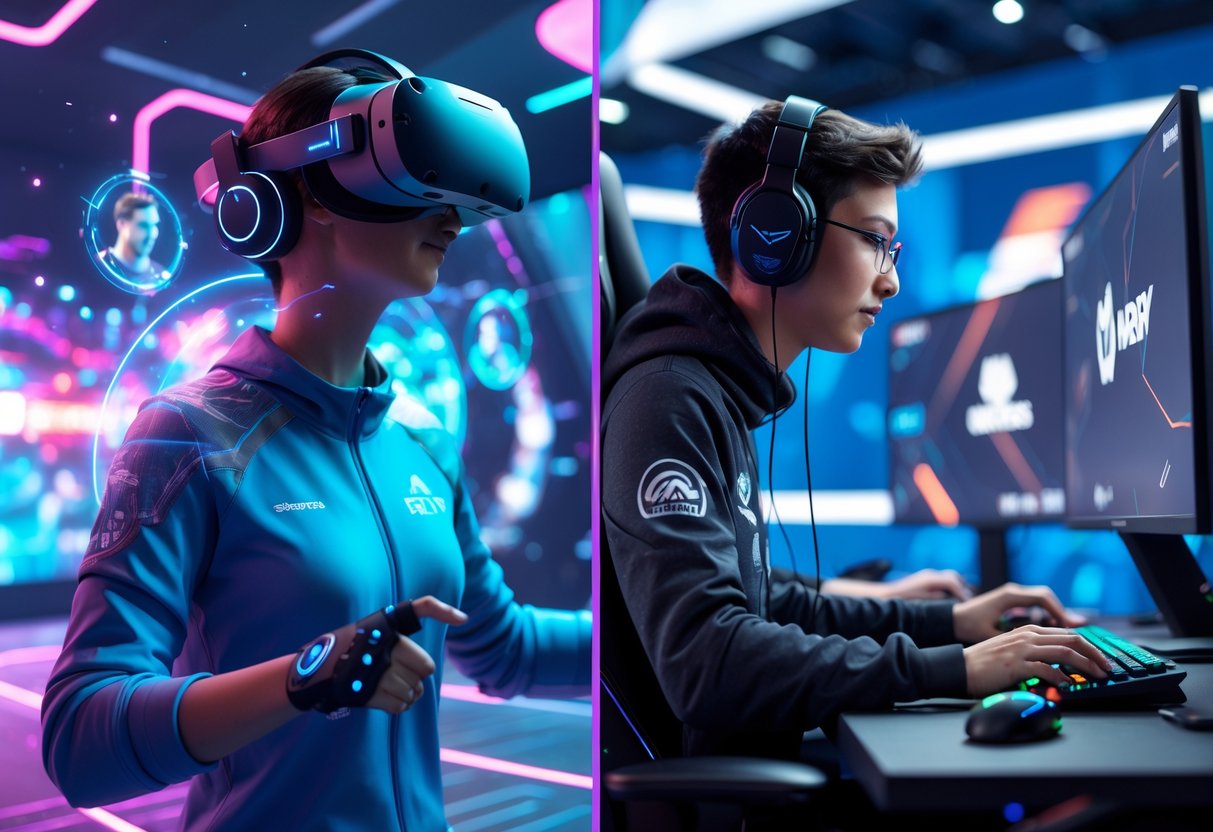
VR esports flips competitive gaming from a controller-in-hand, desk-bound activity into something way more physical. Suddenly, the skills you need—and the gear you use—are totally different.
Physical Engagement Versus Traditional Gameplay
In traditional esports, players stay seated at desks. They compete with keyboards, mice, or controllers.
VR esports throws players into full-body movement. You actually duck to dodge bullets. You swing your arms to wield swords.
This physical side makes VR esports feel closer to real sports. Players need stamina and endurance, not just fast fingers.
Key Physical Differences:
- Traditional: Seated, focus on finger dexterity
- VR: Standing, moving your whole body
- Energy: Traditional players conserve energy; VR players burn calories
VR tournaments look more like athletic events. Spectators watch players sweat and move around their zones. Meanwhile, in traditional esports, the audience just watches the screens.
Physical demands keep sessions short. Most VR matches top out at 30-60 minutes. Traditional esports tournaments can drag on for hours.
New Skill Requirements and Athleticism
VR esports blends digital gaming skills with physical fitness. Players need hand-eye coordination but also solid cardiovascular endurance.
Traditional esports rewards lightning-fast mouse clicks and keyboard shortcuts. VR values spatial awareness and how you position your body.
Essential VR Esports Skills:
- Room-scale movement and positioning
- Physical stamina for longer sessions
- Real-world balance and coordination
- Quick physical reactions to virtual events
Body language becomes a strategy. Opponents might read your physical tells or movement patterns. That adds a psychological layer you just don’t get in traditional esports.
Training routines? Totally different. Traditional pros grind 8-12 hours a day at their computers. VR players have to split time between gaming practice and physical fitness training.
Pro VR players often team up with fitness coaches. They need strong core muscles and good cardio. Traditional esports athletes mostly focus on reaction time and game knowledge.
Platform and Device Diversity
Traditional esports sticks to PCs and consoles. Tournaments use the same setups for fairness.
VR esports faces a mess of equipment. Headsets, tracking systems, and play spaces all impact performance in different ways.
Equipment Requirements:
| Traditional Esports | VR Esports |
|---|---|
| Gaming PC/console | Gaming PC + VR headset |
| Monitor/TV | Room-scale tracking setup |
| Controller/keyboard | Motion controllers |
| Gaming chair | Minimum 2m x 2m play space |
VR headset compatibility brings headaches. Games built for Oculus may not run well on HTC Vive. Traditional esports avoids this by sticking to universal PC platforms.
Setup time isn’t even close. Traditional tournaments just plug in and go. VR events require room calibration, headset fitting, and tracking setup for each player.
Costs run higher for VR esports. A good traditional setup costs £800-1,500. VR setups start around £1,200 and you need a dedicated space.
Tournaments need bigger venues. Traditional esports can pack players into tight rows. VR competitions require individual play zones and safety barriers.
Defining Viability in VR Esports
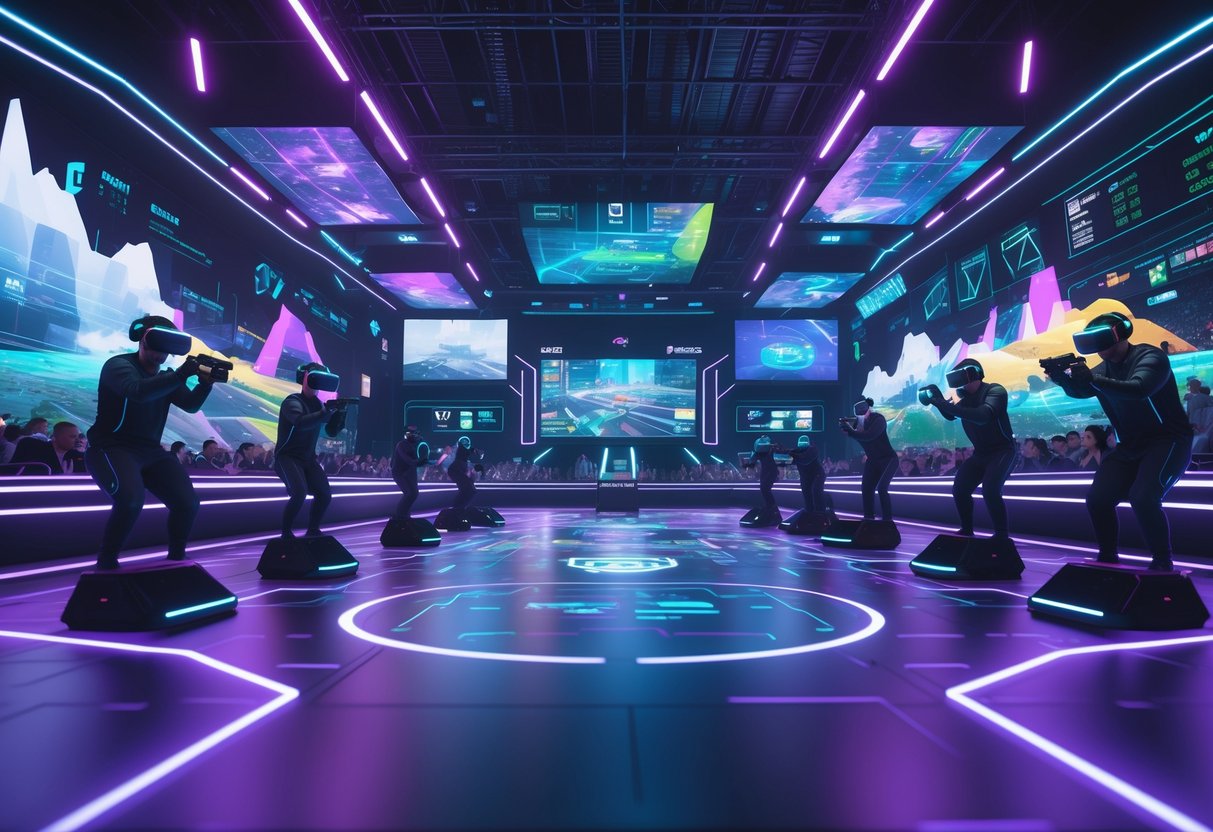
VR esports only works if three things line up: solid technical requirements, business models that attract investment, and real audience demand. If those don’t come together, VR stays stuck as a cool experiment instead of a serious competitive sport.
Key Success Factors for Competitive Play
VR esports runs into challenges that traditional esports just don’t have. Physical endurance really matters—some players can only last 20 minutes before eye strain or motion sickness sets in.
Hardware standardisation causes the biggest headaches. PC gaming has performance differences, but it’s manageable. VR requires everyone to have the exact same equipment for fairness. The Oculus Rift at £399 and HTC Vive at £499 already set a high entry bar compared to free-to-play PC games.
Player development moves slower in VR. Traditional esports athletes grind 8-12 hours a day, but VR limits how much you can practice. That slows down skill growth and team play.
The talent pool looks different. VR esports attracts people who are physically fit and can handle the movement. That opens doors for some, but it shrinks the overall player base.
Current VR titles like Echo Arena and Onward just don’t have the name recognition of games like League of Legends or Counter-Strike. Building an audience is tougher.
Longevity and Sustainability
Financial sustainability is a big question mark for VR esports. Prize pools are way smaller than traditional tournaments, so going pro isn’t easy.
Sponsorships are growing, but slowly. Intel and Oculus back leagues like VR League, but most mainstream brands wait for bigger audiences before jumping in.
Infrastructure is starting to show up, thanks to things like Virtual Athletics League’s 160+ arcade locations worldwide. That helps lower hardware costs for individuals and builds communities.
Tech keeps getting better, and that might solve some current problems. As hardware improves and prices drop, more people can join in. Still, mass adoption feels a few years off.
Broadcasting VR esports is tricky. Traditional esports give you tons of camera angles and slick production. VR makes it harder for viewers to follow the action.
Market Demand Analysis
Audience size is still pretty small compared to traditional esports. Mainstream esports events pull in millions, while VR tournaments struggle to get big numbers.
Geographic reach is all over the place. Esports in general is booming in some regions, but VR esports mostly pops up in tech-heavy areas with arcades.
VR’s physical demands and novelty appeal to a broader age range, but the numbers are smaller. Traditional esports usually attract 16-34 year-old males.
Revenue streams face serious challenges:
| Revenue Source | Traditional Esports | VR Esports |
|---|---|---|
| Sponsorships | High value, proven ROI | Limited, experimental |
| Broadcasting rights | Established market | Minimal demand |
| Merchandise | Strong fan loyalty | Small audience base |
| Ticket sales | Proven model | Arcade-dependent |
Investors seem cautiously optimistic. Big companies put money into VR esports, but nowhere near traditional esports levels.
The future for VR esports hinges on making it more accessible while keeping that unique physical aspect that sets it apart.
Technological Foundations and VR Hardware
Modern VR headsets finally deliver the specs needed for competitive gaming. Wireless tech and cloud processing are starting to break down old barriers. Still, network latency is the big hurdle for VR esports.
Current State of VR Headsets
VR headsets have come a long way. The Meta Quest 3 gives you 4K+ resolution per eye and a 90Hz refresh rate. HTC Vive Pro 2 goes even higher with 2448×2448 per eye.
Key specs for competitive VR:
- Latency: Under 20ms for responsive play
- Field of view: 110+ degrees for decent peripheral vision
- Refresh rate: 90Hz minimum, 120Hz is better
- Weight: Under 600g so players don’t tire out
The Valve Index is still a favorite for serious VR gamers. Its 130-degree field of view helps with spatial awareness. Off-ear audio lets teammates talk clearly during matches.
Tracking has gotten way better. Inside-out tracking means you don’t need external sensors. Players move naturally without losing precision.
Prices have dropped. The Quest 3 starts at £479. Pro headsets like Vive Pro 2 are about £1,300. VR is getting more accessible for competitive players.
Emerging VR Technology Trends
Wireless connectivity is a game-changer for VR esports. Wi-Fi 6E and soon Wi-Fi 7 cut wireless latency down to almost wired levels. Players can finally ditch the cables.
Haptic feedback is getting cooler. Full-body haptic suits give you real sensations for impacts or environmental changes. That’s more info for players to react faster.
Eye-tracking is becoming standard. The Varjo Aero and next-gen headsets use gaze detection to focus rendering where players look. That helps with performance during intense moments.
Standalone processing power keeps improving. Qualcomm’s XR2 chips now handle complex games without a PC. That removes another weak spot for tournaments.
Mixed reality features are blurring the lines between VR and AR. Players can peek at their real surroundings if they need to. Organisers can overlay real info into the virtual world.
Latency and Network Considerations
Network latency is still the toughest technical problem for VR esports. Traditional esports can get by with 50-100ms ping, but VR needs under 20ms to avoid motion sickness and keep things fair.
5G networks promise sub-10ms latency for mobile VR. But venue Wi-Fi often becomes the bottleneck. Organisers have to invest in enterprise-grade networking gear.
Cloud gaming adds more latency. Services like NVIDIA GeForce Now introduce more network hops—each one adds 5-15ms, and that adds up fast.
Intel’s latest chipsets help cut local processing delays. Their integrated graphics handle VR workloads more efficiently, leaving more room for network optimisation.
For tournaments, organisers need to:
- Use dedicated servers within 50km of the venue
- Set up redundant internet from multiple providers
- Keep critical game functions processed locally
- Prepare backup systems for network failures
Motion-to-photon latency has to stay under 20ms total. That includes input, game calculations, rendering, and display refresh. If any part lags, it hurts fairness.
Popular VR Esports Games and Key Titles
A handful of VR games have carved out a spot as esports titles, each with gameplay that really shows off what VR can do. These range from zero-gravity sports to rhythm games and tactical shooters where you have to move your whole body.
Echo Arena and Its Influence
Echo Arena broke new ground by creating a zero-gravity sport that feels totally made for VR. Players use their hands to grab, push, and launch themselves through the arena, all while trying to score.
You need real physical fitness and spatial smarts to play well. Matches can run up to 15 minutes, and you’ll definitely break a sweat.
Key competitive features:
- Team-based: 3v3 matches, everyone has a role
- Physical demands: Players often sweat during intense rounds
- Skill ceiling: Top players pull off crazy movement techniques
Echo Arena tournaments have pulled in thousands of Twitch viewers. The game proves VR can create brand-new sports, not just copy old ones.
Major events include the Echo Combat Championship and plenty of community-run leagues. Prize pools usually range from £500 to £5,000 for the bigger events.
Beat Saber in Competitive Play
Beat Saber started as a casual rhythm game but turned into a real esport thanks to its precise scoring. Players slash blocks to the beat with virtual sabers, and it’s all about accuracy and technique.
Competitive Beat Saber is about custom songs at wild difficulty levels. The best players get nearly perfect scores while staying smooth and efficient.
Competition formats:
- Speed runs: Fastest time on a track
- Accuracy contests: Highest score on set songs
- Endurance challenges: Play multiple songs in a row
The Beat Saber World Cup brings in players from all over, with streams sometimes drawing 50,000+ viewers. The steady flow of custom songs keeps the scene fresh.
Unlike other VR esports, Beat Saber doesn’t need much space and is easy for spectators to follow.
Rise of VR Shooter Genres
VR shooters like Onward have shaped tactical gaming in ways you just can’t get from traditional esports. In these games, players physically aim, reload, and take cover using their own bodies.
Onward stands out in the tactical VR shooter world with its realistic military simulation. Players coordinate their movements, call out positions, and execute strategies—all while dealing with real physical fatigue.
Competitive advantages:
- Realistic tactics: Military maneuvers map directly to gameplay
- Physical skill: Quick reflexes and steady hands really matter
- Immersion factor: You actually feel present in the firefights
Pavlov VR brings faster-paced action, a bit like Counter-Strike but with full-body movement. Most tournaments use elimination rounds with teams of 5v5.
Population: One mixes battle royale gameplay with VR climbing and shooting. Competitors need to manage stamina as well as shooter skills.
VR shooter tournaments struggle with broadcasting since it’s tough for spectators to follow first-person VR action. Still, new camera systems are making the viewer experience much better.
Spectator Experience and Immersive Viewing
VR tech is changing how fans watch esports by placing them right inside virtual arenas instead of just watching a flat stream. AR overlays add live stats and interactive features, turning viewers into participants.
Immersive Spectator Modes
Platforms like Bigscreen and VRChat let fans join virtual stadiums during live tournaments. You get to pick your angle, stand next to players, or watch from wild camera spots.
These platforms support custom avatars and live voice chat. Fans react together during big moments, building an atmosphere that feels a lot like being in a real venue.
Popular VR spectator features:
- Move your camera anywhere in the arena
- Switch between player perspectives
- Crowd reactions sync up for dramatic moments
- Control interactive replays
The Meta Quest 3 and HTC Vive Pro 2 deliver the sharpest viewing quality. Both offer 4K+ resolution per eye and low latency.
Quick win: Try Bigscreen VR (it’s free) to catch tournament highlights before jumping into live events.
3D Arenas and Virtual Venues
Developers recreate iconic tournament venues in 3D for virtual events. Big events like Intel Extreme Masters now have VR experiences running alongside their regular broadcasts.
These digital arenas break free from real-world limits. Developers create floating platforms, see-through walls, and lighting that reacts to the game.
Key features of modern VR venues:
- Host thousands of viewers at once
- Offer multiple viewing zones (close-up, overview, player booths)
- Enable real-time audience interaction
- Allow custom branding and sponsor banners
Unity and Unreal Engine power most of these tournament spaces. They handle crowd rendering and bring in real-time data.
Many venues are free to enter, but premium seats cost extra. VIP areas might have special commentary or behind-the-scenes access.
Engagement Through AR Overlays
AR shakes up esports viewing by projecting data directly onto your screen or smart glasses. Microsoft’s HoloLens 2 can show floating stats, health bars, and tactical info right before your eyes.
Live tournaments use AR to display hero picks, kill counts, and economic data above players. These overlays help new viewers keep up in games like Dota 2 or League of Legends.
Common AR viewing enhancements:
- Live stats floating next to players
- Tactical overlays that show team positions
- Interactive timelines you can scrub through
- Predictive analytics for upcoming fights
Mobile AR apps let you point your phone at streams to get extra info without needing fancy gear.
Warning: Most AR apps need a solid internet connection and a decent phone to work well.
Player Development and Training in VR Esports
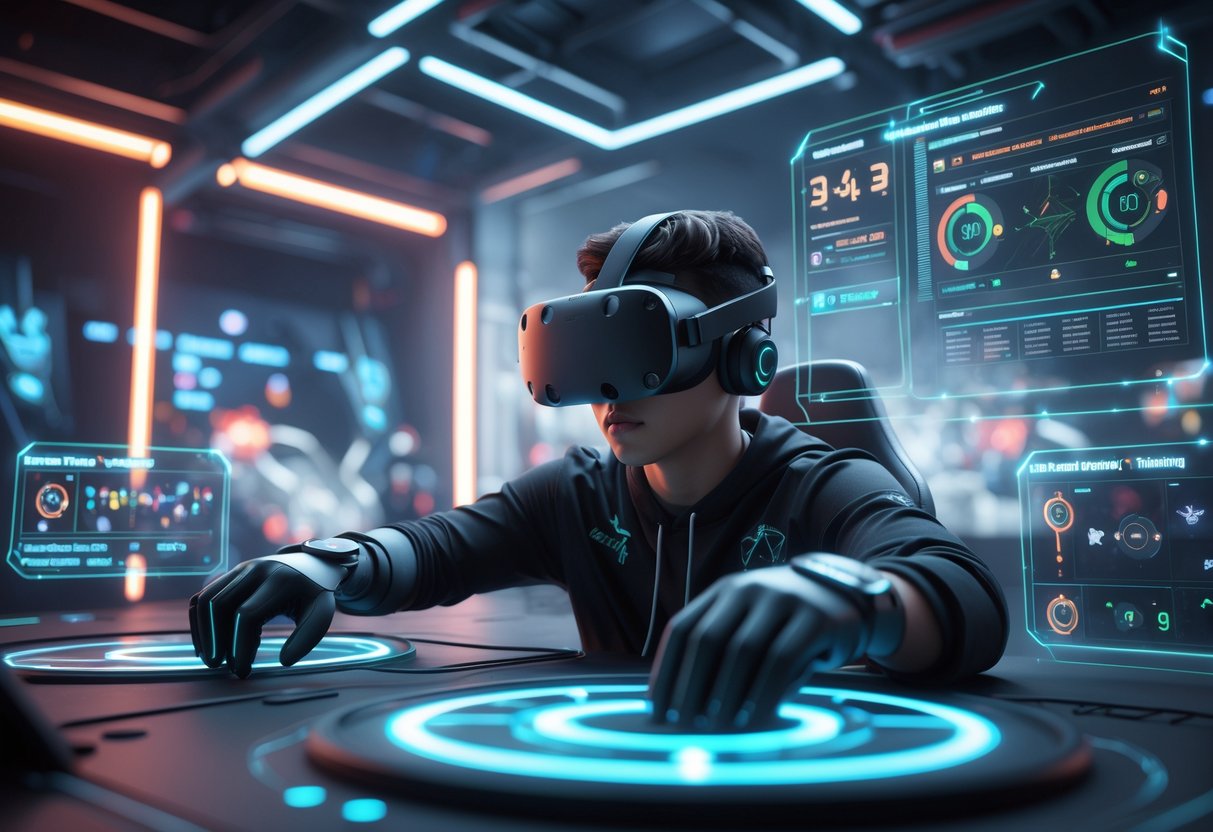
VR training programs are shaking up how esports athletes build skills. Players use immersive physical movement, focused cognitive drills, and real-time analysis. These systems blend classic gaming skills with full-body coordination, giving coaches a level of insight that’s honestly pretty wild.
Physical and Cognitive Skill Building
VR esports needs a mix of physical movement and fast thinking you just don’t get from regular games. Players build hand-eye coordination with games like Beat Saber, and studies show even amateurs get better after just eight days of short sessions.
The physical side is no joke. VR headsets make you duck, dodge, and swing your arms with real precision. You end up working your heart and muscles, not just your brain.
Key cognitive boosts:
- Faster reaction times from immersive play
- Stronger spatial memory from navigating 3D worlds
- Better multi-tasking under physical stress
- Improved focus during full-body gameplay
Players often say they focus and make decisions better after VR training. The tech forces you to process visuals while moving, building new neural connections that help with gaming overall.
Most training starts with 15-20 minute sessions to avoid motion sickness. As players adjust, they work up to 45-60 minutes to build stamina for matches.
Simulation-Driven Practice
Platforms like Aim Lab VR and STRIVR let players practice in controlled spaces, analyzing every tiny movement. They track hand position, reaction speed, and accuracy with a level of detail you just can’t get in standard gaming.
Training simulations offer:
- Practice in match-like environments without travel
- Repeat scenarios to sharpen strategies
- Collect performance data to spot weaknesses
- Adjust difficulty as you improve
Coaches can crank up the pressure by simulating real arena crowds and stage lighting. This helps players handle nerves when it’s time for the real thing.
Cost is still a factor. Pro VR setups run from £800-£3,000, though some training centers rent access for £20-40 an hour.
The data is a game-changer. Players get detailed reports on movement, reactions, and progress. This feedback speeds up improvement way more than old-school practice.
Innovative Coaching Tools
VR headsets let coaches watch from the player’s perspective in real time, which just wasn’t possible before. Coaches see exactly what players see, spot decision patterns, and suggest tactical tweaks on the fly.
Modern coaching features:
- Record live matches from the player’s view
- Analyze and correct movement patterns
- Train positioning in 3D environments
- Compare performance to the pros
Biometric tools push things further. Heart rate monitors and eye-tracking reveal stress and focus levels during play. Coaches use this info to build mental resilience programs.
Remote coaching is now doable. Coaches around the world can work with players without travel, opening up access to top-level advice.
Heads up: Many coaching platforms are pricey. Check credentials and results before dropping cash. Free, community-run sessions can offer a lot for up-and-coming players.
This tech lets coaches assess skills with a level of detail that can turn amateurs into real contenders in just months.
Esports Leagues, Competitions, and Growing Infrastructure
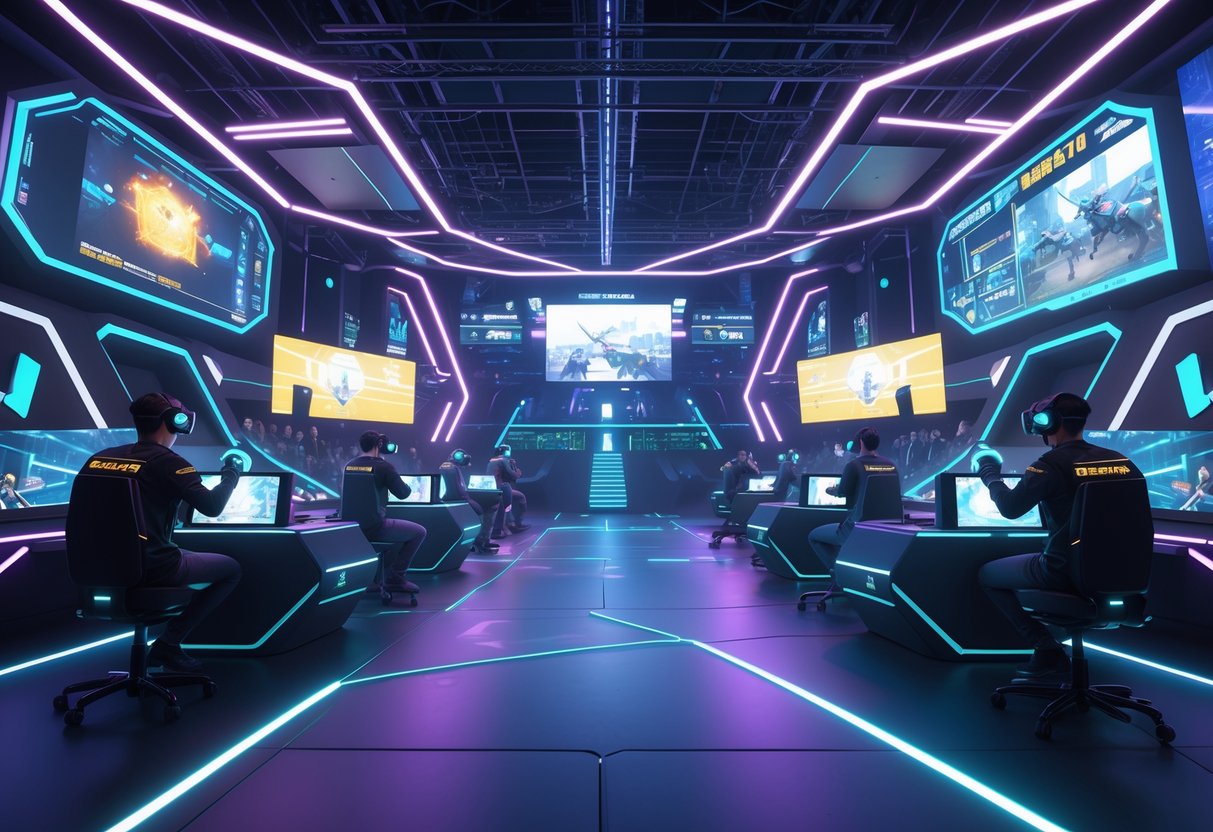
VR esports now has organized leagues like the VR Challenger League and VR Master League. Major tech companies and traditional esports orgs are starting to back the scene with funding and infrastructure.
VR Esports Leagues and Tournaments
Major VR Competitions:
- VR Challenger League – International circuit
- VR Master League – Pro-level tournaments
- ESL Gaming VR events – Big in the US
Popular games include Echo Arena (zero-gravity team play), Beat Saber (rhythm battles), and Population: One (battle royale action).
Players join from all over the world. Unlike traditional esports, spectators can watch both the game and the players’ real movements.
Prize pools are still pretty modest. Most VR competitions offer £1,000-£10,000, but that’s slowly growing as more people tune in.
Sponsorships and Institutional Support
Intel has poured money into VR esports infrastructure, offering processing power and tech support for big tournaments. Their involvement shows the sector has real potential.
Oculus (now Meta) sponsors VR competitions and supplies headsets. Direct hardware support is a huge help for event organizers.
Traditional esports orgs are dipping their toes into VR, but right now, most sponsors are tech companies, not big consumer brands.
The sponsorship scene is still pretty limited compared to mainstream esports. Most money goes to hardware and venues, not player salaries.
Role of Industry Stakeholders
Tournament Organisers like ESL Gaming now run dedicated VR events. They bring their esports know-how and help make VR competitions more professional.
Hardware Manufacturers play a huge role in VR esports. Unlike regular gaming, VR needs specialized gear, which raises the entry bar.
Venue Operators face unique issues. VR players need plenty of space, so venues must be bigger than standard esports setups.
Gaming analyst James Connolly puts it bluntly: “VR esports infrastructure is behind where player interest is. We need more standardized tournaments and easier access to practice spaces.”
Specialized VR centers are popping up in big cities. They offer practice space and host local tournaments, fueling grassroots growth.
Accessibility and Cost Barriers
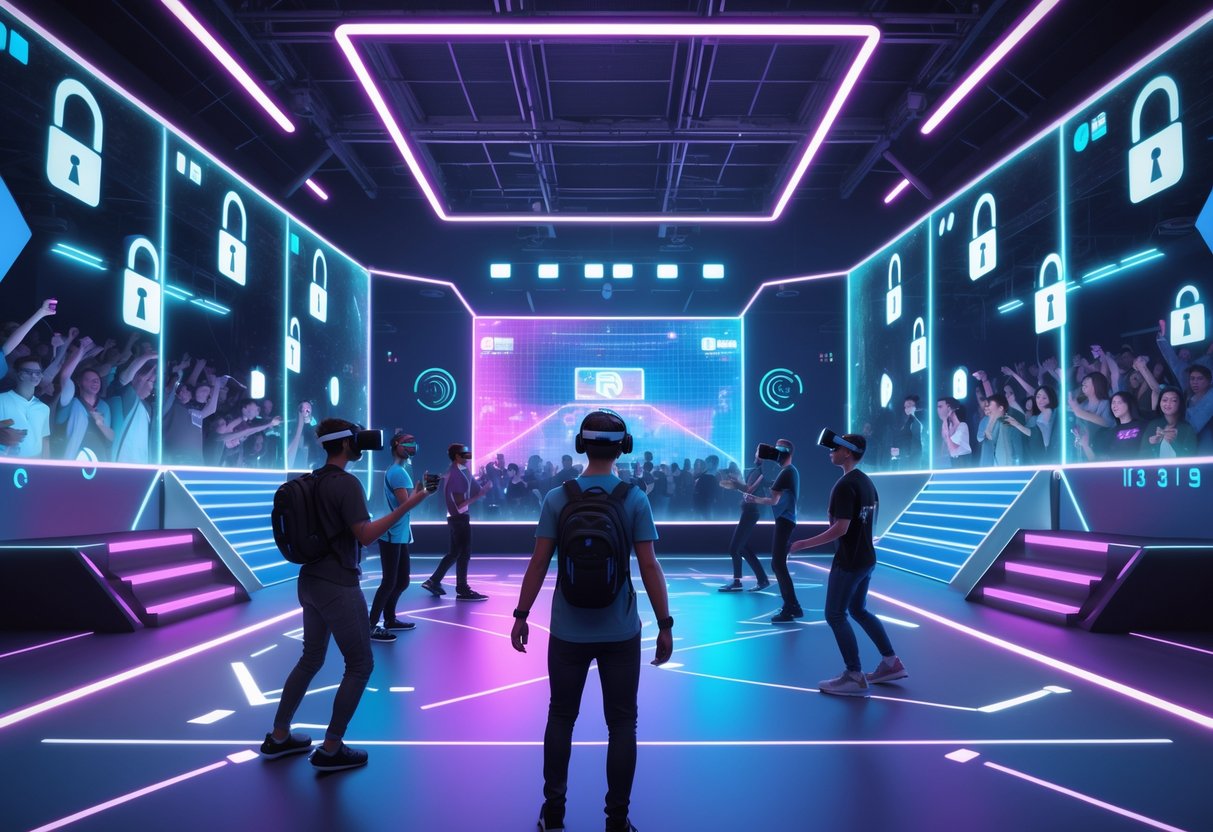
The steep price of VR gear and tricky setup needs make it tough for VR esports to go mainstream. Good VR headsets cost a lot, need powerful gaming PCs, and demand dedicated space that many people just don’t have at home.
Affordability of VR Hardware
Entry-level VR headsets start at £300-400 for models like the Meta Quest 2, but for serious competitive gaming you’ll want something in the £600-1,200 range. The Valve Index, often considered the gold standard, sits around £900.
But that’s just the headset. You also need a beefy gaming PC, usually £1,000-2,500 minimum.
Total cost? £1,300-3,700 for a proper VR setup. Compare that to traditional esports, where you can get going for under £800.
Replacement costs add up. VR controllers break more often from all the movement, and headset screens can get damaged from drops or rough sessions.
| VR Setup Component | Budget Option | Competitive Standard |
|---|---|---|
| VR Headset | £300-400 | £600-900 |
| Gaming PC | £1,000 | £1,500-2,500 |
| Controllers/Accessories | £100-200 | £200-400 |
| Total Cost | £1,400-1,600 | £2,300-3,800 |
Home Set-Up and Space Requirements
VR gaming needs a lot of space—usually at least 2m x 1.5m clear, and more for competitive play.
This knocks out a lot of would-be players. If you’re a student in a small flat or sharing a house, it’s almost impossible.
Traditional esports let you play from any desk or shared room. VR’s movement demands mean you need a dedicated area with no furniture, walls, or breakables in the way.
Safety’s another issue. Players moving fast in headsets can easily bump into things or get hurt. Pro VR setups often pad the walls and floors.
Noise is a real problem too. VR gaming is louder and more physical, so it can annoy roommates, family, or neighbors in ways that regular gaming doesn’t.
Entry-Level Options
Standalone headsets like the Meta Quest 2 give you the easiest way in, usually for about £300-400, and you don’t need a pricey gaming PC. But honestly, these headsets can’t always keep up with the demands of competitive gaming.
You’ll notice the graphics and frame rates aren’t really up to snuff for serious players. If you try streaming demanding games from outside servers, network lag can pop up too.
Some developers are building VR games just for standalone headsets. They trade off some visual quality to make things more accessible, but not many of these games have really taken off in competitive circles.
If you’re open to it, second-hand VR gear can save you money. But there are risks—think hygiene, lack of warranty, and the fact that VR tech gets outdated fast.
Quick win: Try out VR at gaming cafés or arcades first. You get to experiment with different headsets and games, all without dropping a ton of cash.
Warning: Don’t go for the cheapest VR gear if you want to compete. Bad tracking and high latency will just frustrate you, maybe even turn you off VR for good.
Challenges to Mainstream Adoption
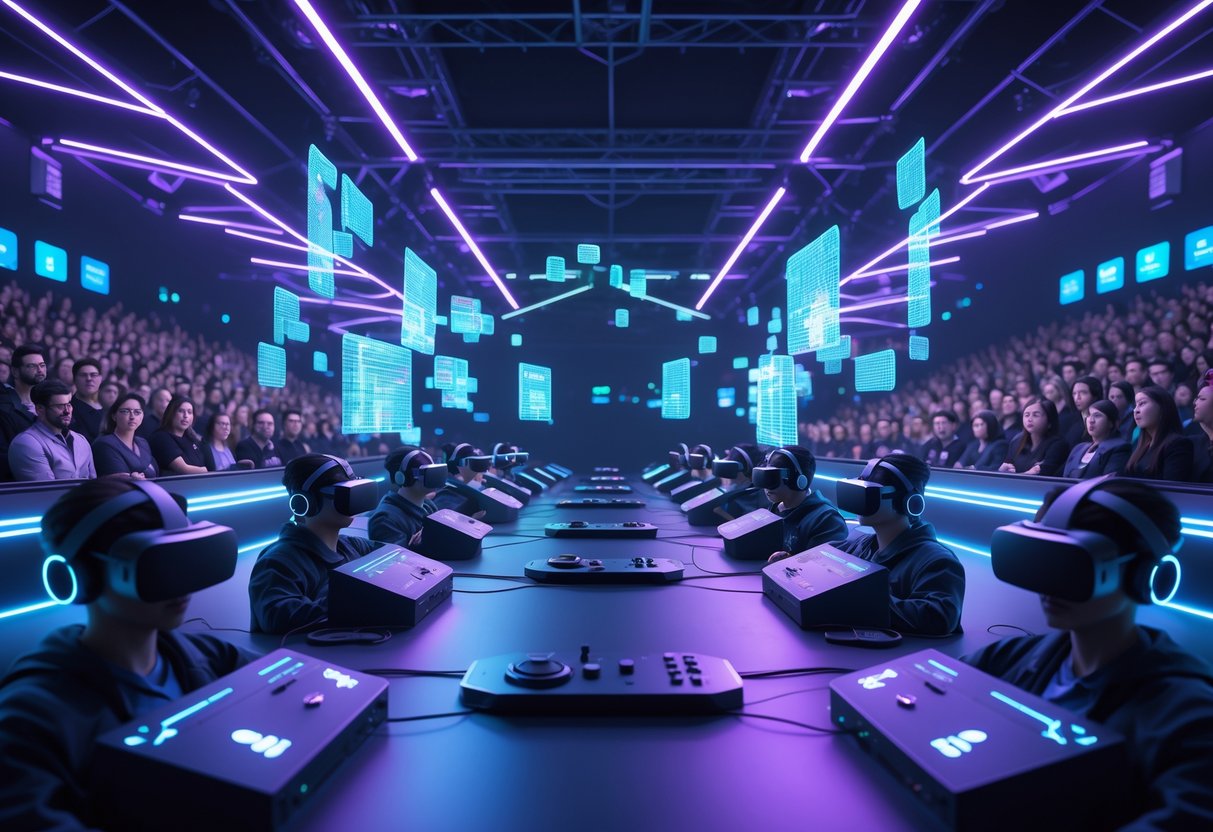
VR esports runs into some big technical walls, weird rules questions, and honestly—not-great viewing experiences. High latency, unclear standards, and awkward ways to watch all slow down both player and audience growth.
Technical Limitations
Latency is still the main technical headache in competitive VR gaming. Most headsets add 15-20 milliseconds of motion-to-photon delay, which means hardware can give some players an unfair edge.
Pro esports need lightning-fast reactions. Games like Counter-Strike expect response times under 10ms, and VR just can’t reliably hit that mark.
Hardware demands make accessibility tough. If you want a solid VR esports setup, expect to spend £2,000-£4,000. That’s way more than the £400-£600 you’d pay for a console. You’ll need a beefy PC, a top-tier headset, and enough space to play.
Motion sickness is a real problem for 30-40% of VR users, especially during long sessions. If matches run for 2-3 hours, a lot of people just can’t handle it. That shrinks the pool of potential competitors.
Tracking can get inconsistent and mess with fairness. Room-scale tracking works differently at each venue, so players who know a setup get an advantage. Standardising tournament hardware is expensive and complicated.
Regulatory and Competitive Fairness
Nobody oversees VR esports standards right now. Traditional esports have leagues, drug testing, and equipment rules, but VR doesn’t have any of that yet.
Standardising equipment is a pain. Unlike keyboards and mice, VR headsets can be wildly different in field of view, refresh rate, and tracking. The Valve Index gives you 130-degree FOV, while the Quest 2 only does 90.
Player eligibility gets tricky when you think about physical disabilities. VR esports need certain mobility that regular gaming doesn’t. Making competitions inclusive without splitting them up is still a big question.
Age limits are fuzzy. Most VR makers say 13+ is the minimum, but plenty of traditional esports include younger kids. Organisers worry about letting minors use VR for long periods.
Anti-cheat tools for room-scale VR just aren’t here yet. People could use physical hacks or tweak their play space, and it’s almost impossible to catch that remotely.
Viewer Experience Hurdles
VR esports are just not fun to watch right now. Spectators can’t feel the immersion that makes VR cool. Seeing players flail around on screen looks more silly than competitive.
Broadcasting VR is messy. Mixed reality capture needs pricey equipment and tech skills that most organisers don’t have. Production costs shoot up by 300-400% compared to regular esports.
Audience numbers drop a lot for VR tournaments. Twitch viewers for VR events are about 50-80% lower than for traditional esports. People struggle to follow what’s happening or get the strategy.
It’s tough for commentators too. Casters can’t always see what players are doing or guess their next move. The 3D action in VR makes classic play-by-play almost impossible.
Venues run into space issues. Every VR player needs at least 2×2 metres, unlike the compact setups for regular gaming. This means higher venue costs and fewer seats for spectators.
Comparison with Leading Traditional Esports Titles

Traditional esports like League of Legends, Dota 2, and Counter-Strike completely dominate the scene, with millions of players and viewers. VR titles haven’t matched their easy access, watchability, or strong competitive infrastructure.
League of Legends Versus VR Titles
League of Legends pulls in over 180 million players each month and its viewership blows VR esports out of the water. For example, the 2023 World Championship hit 6.4 million concurrent viewers. Plus, it’s free-to-play, so there’s no expensive headset barrier like with VR.
Watching League matches is a breeze. Anyone can tune in, and the overhead cameras make it easy to follow. With VR esports, like Echo Arena, most viewers just get confused or even dizzy.
The skill ceiling in League is massive. Players spend years mastering over 160 champions, item builds, and team play. VR games like Beat Saber or Pavlov focus more on physical skill, but they don’t have the same strategic depth that keeps fans coming back.
Infrastructure is another big gap. League runs leagues in tons of regions, with set formats and clear paths from amateur to pro. VR esports don’t have this kind of structure yet.
Dota 2 and Counter-Strike Comparisons
Dota 2’s International tournament hands out prize pools over £30 million, all funded by the community. That works because millions of people buy battle passes. VR just doesn’t have the numbers to pull off anything like that.
Counter-Strike has stuck around for more than 20 years with gameplay that’s easy to watch. Anyone can tune in and get the goal—eliminate the other team or finish the objective. VR games usually need a lot of explanation about movement and how things work.
Physical demands set VR apart. Counter-Strike is all about fast mouse work and quick reactions, usually while sitting. VR esports need full-body movement and spatial awareness. Sure, it’s more athletic, but it’s also more tiring and tough to keep up through long tournaments.
Technical reliability is a win for traditional esports. Counter-Strike runs on standard PCs with very little fuss. VR tournaments often struggle with headset calibration, tracking glitches, and space issues that can interrupt matches.
Lessons from Established Franchises
Accessibility is the foundation for big esports. League and Counter-Strike took off because anyone with a basic PC could play. VR’s high hardware costs really hold it back.
Spectator appeal drives success. Traditional games offer slick camera work, stats overlays, and lively commentary. VR broadcasts can feel cramped or confusing, especially for new viewers.
Communities grow naturally in traditional esports thanks to ranked ladders, social tools, and easy content sharing. Players stream, clip highlights, and build fanbases. VR just doesn’t have these social features yet.
Developer backing keeps scenes alive with regular updates, partnered tournaments, and prize money. Riot and Valve pour resources into their games. VR devs usually don’t have the same budget or long-term plans for esports.
The Future of VR Esports
VR esports might soon reach beyond gaming, thanks to cross-reality tech, education, and fitness competitions. Market forecasts look strong as hardware gets cheaper and better.
Cross-Reality and AR Integration
Mixed reality tournaments are popping up as the next big thing. We’re starting to see events where VR players compete right alongside AR spectators in the same digital space.
Tech giants are building platforms that blend VR headsets with AR overlays. Viewers can check out game stats, player health, and tactics right on their screens during matches.
Augmented reality lets fans bring holographic players into their homes. Some developers are testing AR apps that sync with VR tournaments, which sounds wild but could really take off.
This tech enables hybrid competitions—some players use VR, others join in with AR devices. That could open up competitive gaming to way more people.
Early tests suggest mixed reality events boost viewer engagement by 40% compared to VR-only tournaments. Broadcasting companies are already investing in AR tools for the 2026 season.
Predicted Growth and Market Impact
Industry experts predict the VR esports market will hit £2.1 billion by 2028. Right now, it’s about £180 million for 2025.
Headset prices are dropping, so player numbers might triple in the next three years. Big investments from Meta and Apple suggest mainstream adoption is picking up speed.
The whole esports industry benefits from VR’s visual spectacle. Traditional sports broadcasters are taking notice and starting to feature VR events because they look so different.
Tournament prize pools are climbing fast:
| Year | Average Prize Pool | Major Tournaments |
|---|---|---|
| 2024 | £85,000 | 12 |
| 2025 | £150,000 | 28 |
| 2026* | £280,000* | 45* |
*Projected figures
Big brands are moving into VR esports as they see the marketing potential. Nike and Adidas have already signed deals with VR fitness leagues.
Potential for Educational and Fitness Applications
Schools and universities are adopting VR esports to teach teamwork and tech skills. Some universities say student engagement is 65% higher in VR-based competitive courses than in regular esports.
We’re seeing more fitness-focused VR tournaments that mix gaming with exercise. Beat Saber competitions now track heart rate and calories burned as part of the scoring.
Schools are adding VR esports to PE classes, hoping to fight the idea that gaming is always sedentary. Some early programs show students get fitter and more social.
Companies are adding VR fitness leagues to their wellness programs. They report lower healthcare costs and happier employees thanks to these VR competitions.
The education world sees VR esports as a way into STEM careers. Students pick up programming, 3D design, and hardware skills through gaming.
Mental health uses are on the rise too, with therapeutic VR games used in structured competitions for rehab and social development.
Frequently Asked Questions

Here are some of the most common questions people have about VR esports, from setup costs to fair play.
What are the potential benefits of incorporating virtual reality into competitive gaming events?
VR adds a whole new layer of excitement by making players move physically during matches. It’s just more dynamic and, honestly, pretty fun to watch.
Spectators get to see matches from inside the virtual world. They can pick camera angles and feel way more involved in the action.
VR games combine physical skills with gaming smarts. This draws in people who like both mental strategy and athletic movement.
VR also opens the door for competition types you just can’t do with regular gaming setups.
How is player performance affected when competing in virtual reality as opposed to traditional gaming setups?
VR gaming takes way more physical stamina than traditional esports. Players have to train their bodies and their gaming skills.
Reaction times change in VR because you’re moving your whole body, not just your hands. Hand-eye coordination becomes full-body coordination.
Some players get motion sick if they play too long. That can hurt performance, so you have to build up tolerance over time.
Staying in shape really matters for VR esports. Fit players usually last longer and perform better in long matches.
What measures are being taken to ensure fair play and prevent cheating in VR esports tournaments?
Tournament organisers hand out standardised gear so everyone uses the same hardware. This keeps things fair and stops people from gaining an edge with expensive equipment.
Officials check play spaces to make sure they’re the right size. Bigger spaces could let some players move more and get an unfair advantage.
Referees keep an eye out for interference or unsafe play. VR tournaments need new safety rules that traditional esports never had to think about.
Developers are working on anti-cheat software built just for VR. It’s still early days, but the tools are getting better.
Could you elaborate on the spectator experience for VR esports and how it compares to watching traditional esports?
VR esports lets spectators dive right in—if you’ve got a headset, you can actually watch from inside the game world. Honestly, it feels a bit like sitting in a cinema, except you’re surrounded by the action.
But hey, you don’t need fancy gear. Traditional broadcasts still work for VR esports, so plenty of folks just tune in on their phones or computers.
Commentators really step up in VR esports. Since the action gets pretty wild, skilled presenters break down all those physical moves so viewers can keep up.
When there’s a live audience, people get even more into it. Watching players move around on stage just makes the whole thing more entertaining.
What kind of investment is needed for both players and organisers to participate in VR esports?
Players have to shell out for a solid VR headset—think anywhere from £300-500 if you’re aiming for something competitive. If you want a pro-level setup, you might be looking at £1,000 or more.
You can’t really skip on space either. Most players need at least a 2×2 metre area, so a lot of folks end up rearranging their rooms or even upgrading their space just to play.
Organisers run into higher venue costs since every competitor needs their own play area. Traditional esports squeeze more people in, but VR just isn’t that simple.
On top of that, insurance and safety get expensive. Organisers have to bring in medical staff and set up strict safety protocols at VR events.
How are the current advancements in VR technology shaping the future of esports competitions?
Lighter headsets let players enjoy longer gaming sessions without feeling weighed down.
That means tournament matches can last as long as they need to.
Wireless setups have finally solved the frustrating cable tangling problem from the early days.
Now, players get to move around with way more freedom.
Improved tracking systems make competitive play a lot more accurate.
If you want fair matches, you really need precise movement detection.
As prices keep dropping, more gamers can actually afford VR.
With that, the competitive scene keeps growing and feels more exciting every year.

